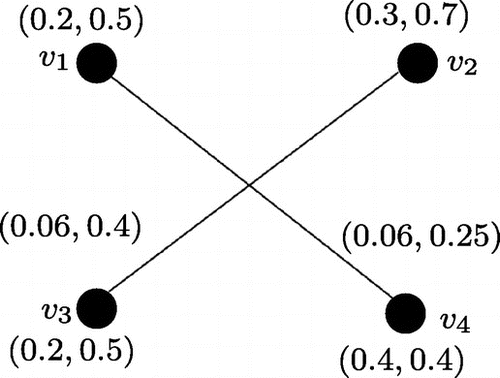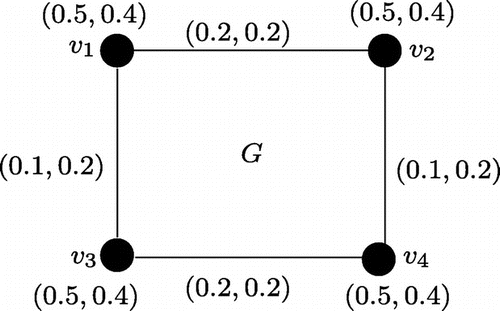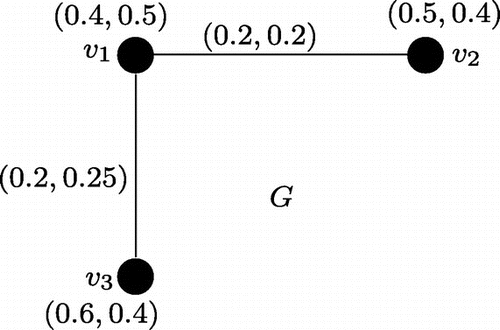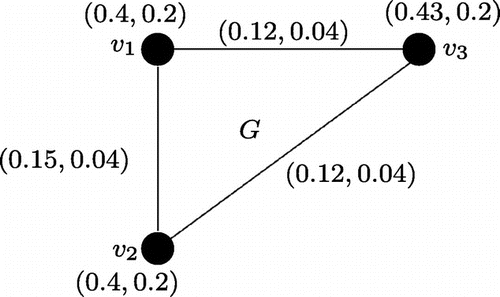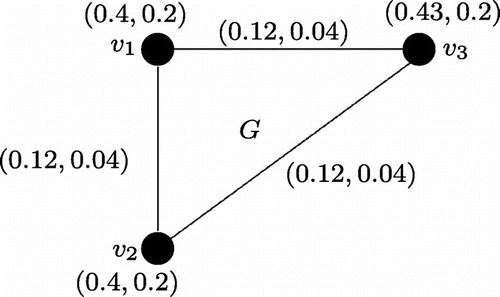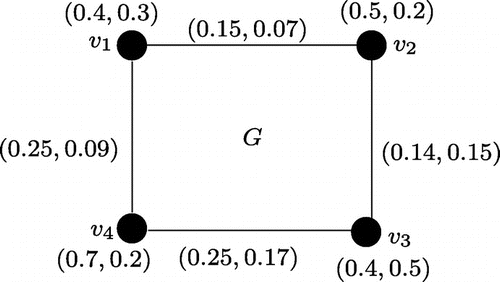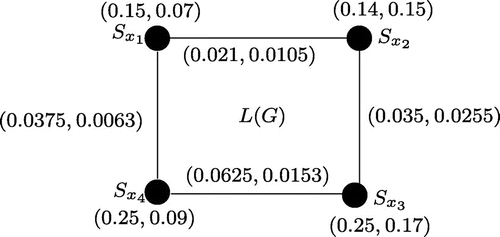 ?Mathematical formulae have been encoded as MathML and are displayed in this HTML version using MathJax in order to improve their display. Uncheck the box to turn MathJax off. This feature requires Javascript. Click on a formula to zoom.
?Mathematical formulae have been encoded as MathML and are displayed in this HTML version using MathJax in order to improve their display. Uncheck the box to turn MathJax off. This feature requires Javascript. Click on a formula to zoom.Abstract
Vague graph is a generalized structure of fuzzy graph which gives more precision, flexibility, and compatibility to a system when compared with systems that are designed using fuzzy graphs. In this paper, we introduced the notion of regular, totally regular product vague graphs, and product vague line graph. We proved that under some conditions regular and totally regular product vague graph becomes equivalent. Some properties of product vague line graph are investigated. We showed that a product vague graph is isomorphic to its corresponding product vague line graph under some conditions.
Public Interest Statement
The theoretical concepts of graphs are highly utilized by computer science applications, especially in research areas of computer science such as data mining, image segmentation, clustering, image capturing, and networking. The vague graphs are more flexible and compatible than fuzzy graphs due to the fact that they have many applications in networks. In this paper, the concept of vague sets is applied to define and study many important properties of regular, totally regular product vague graphs and product vague line graphs.
1. Introduction
Now a days, most mathematical models are developed using fuzzy sets to handle various types of systems containing elements of uncertainty. In 1993, Gau and Buehrer (Citation1993), introduced the notion of vague set theory as a generalization of Zadeh fuzzy set theory (Citation1965). Vague sets are higher order fuzzy sets. Application of higher order fuzzy sets makes the solution-procedure more complex, but if the complexity on computation-time, computation-volume, or memory-space are not matters of concern, then we can achieve better results. In a fuzzy set, each element is associated with a point-value selected from the unit interval [0, 1], which is termed as the grade of membership in the set. Instead of using point-based membership as in fuzzy sets, interval-based membership is used in a vague set. The interval-based membership in vague sets is more expressive in capturing vagueness of data. There are some interesting features for handling vague data that are unique to vague sets. For example, vague sets allow for a more intuitive graphical representation of vague data, which facilitates significantly better analysis in data relationships, incompleteness, and similarity measures.
Considering the fuzzy relations between fuzzy sets, Rosenfeld (Citation1975) first introduced the concept of fuzzy graphs in 1975 and developed the structure of fuzzy graphs, obtaining analogous of several graph concepts. Ramakrishna (Citation2009) introduced the concept of vague graphs. Akram et al. studied some properties of vague graphs (Akram, Chen, & Shum, Citation2013), vague hypergraphs (Akram, Gani, & Saeid, Citation2014), regularity in vague intersection graphs (Akram, Dudek, & Yousaf, Citation2014), irregular and highly irregular vague graphs (Akram, Feng, Sarwar, & Jun, Citation2014), and vague cycles and vague trees (Akram, Feng, Sarwar, & Jun, Citation2015). Talebi, Rashmanlou, and Mehdipoor (Citation2013), Talebi, Mehdipoor, and Rashmanlou (Citation2014) studied isomorphism and operations on vague graphs. Borzooei and Rashmanlou (Citation2015a, Citationb, Citationc, Citation2016), Rashmanlou and Borzooei (Citation2015, Citation2016, Citation2015) introduced manynew concepts of vague graphs. Samanta et al. introduced fuzzy competition graphs (Samanta, Akram, & Pal, Citation2013; Samanta & Pal, Citation2015), fuzzy planar graphs (Samanta & Pal, Citation2015), bipolar fuzzy intersection graphs (Samanta & Pal, Citation2014), and strength of vague graphs (Samanta, Pal, Rashmanlou, & Borzooei, Citation2016). Later on, Ghorai and Pal studied some properties of generalized m-polar fuzzy graphs (Citation2016a), defined operations and density of m-polar fuzzy graphs (Citation2015), introduced m-polar fuzzy planar graphs (Citation2016b), and defined faces and dual of m-polar fuzzy planar graphs (Citation2016c). In this paper, the concept of regular, totally regular product vague graphs, and product vague line graphs are introduced. Necessary and sufficient condition is established under which regular and totally regular product vague graph becomes equivalent and a product vague graph is isomorphic to its corresponding product vague line graph.
2. Preliminaries
In this section, we point out some basic definitions of graphs. The readers are encouraged to see these references (Balakrishnan, Citation1997; Harary, Citation1972; Mordeson & Nair, Citation2000) for further study.
Definition 2.1
Harary (Citation1972) A graph is an ordered pair , where V is the set of vertices of
and E is the set of all edges of
. Two vertices x and y in an undirected graph
are said to be adjacent in
if xy is an edge of
. A simple graph is an undirected graph that has no loops and not more than one edge between any two different vertices.
A subgraph of a graph is a graph
, where
and
.
We write to mean
, and if
, we say x and y are adjacent. Formally, given a graph
, two vertices
are said to be neighbors or adjacent nodes, if
. The neighborhood of a vertex v in a graph
is the induced subgraph of
consisting of all vertices adjacent to v and all edges connecting two such vertices. The neighborhood of v is often denoted by N(v). The degree
of vertex v is the number of edges incident on v. The open neighborhood for a vertex v in a graph
consists of all vertices adjacent to v but not including v, i.e.
. If v is included in N(v), then it is called closed neighborhood for v and is denoted by N[v], i.e.
. A regular graph is a graph where each vertex has the same open neighborhood degree. A complete graph is a simple graph in which every pair of distinct vertices has an edge.
An isomorphism of the graphs
and
is a bijection between the vertex sets of
and
such that any two vertices
and
of
are adjacent in
if and only if
and
are adjacent in
. If
and
are isomorphic, then we denote it by
.
The line graph of a simple graph
is a graph which represents the adjacentness between edges of
. For a graph
, its line graph
is a graph such that:
| (i) | Each vertex of | ||||
| (ii) | Two vertices of | ||||
Definition 2.2
Gau and Buehrer (Citation1993) A vague set on a non-empty set X is a pair , where
,
are true and false membership functions, respectively, such that
for all
.
In the above definition, is considered as the lower bound for degree of membership of x in A (based on evidence for), and
is the lower bound for negation of membership of x in A (based on evidence against). Therefore, the degree of membership of x in the vague set A is characterized by the interval
. So, a vague set is a special case of interval-valued sets studied by many mathematicians and applied in many branches of mathematics. Vague sets also have many applications. The interval
is called the vague value of x in A and is denoted by
. We denote zero vague and unit vague value by
and
, respectively.
It is worth to mention here that interval-valued fuzzy sets are not vague sets. In interval-valued fuzzy sets, an interval-valued membership value is assigned to each element of the universe considering the “evidence for x” only, without considering “evidence against x”. In vague sets both are independently proposed by the decision-maker. This makes a major difference in the judgment about the grade of membership.
A vague relation is a further generalization of a fuzzy relation.
Definition 2.3
Ramakrishna (Citation2009) Let X and Y be ordinary finite non-empty sets. We call a vague relation a vague subset of , that is an expression R defined by
, where
and
, which satisfies the condition
, for all
.
Definition 2.4
Ramakrishna (Citation2009) A vague relation B on a set V is a vague relation from V to V. If A is a vague set on a set V, then a vague relation B on A is a vague relation which satisfies and
for all
.
Definition 2.5
Ramakrishna (Citation2009) Let be a crisp graph. A pair
is called a vague graph of
, where
is a vague set on V and
is a vague set on
such that
and
for each
.
We call A the vague vertex set of G and B as the vague edge set of G, respectively.
A vague graph G is said to be strong if and
for all
.
A vague graph G is said to be complete if and
for all
.
3. Regular and totally regular product vague graphs
Throughout the paper, represents a crisp graph and G is a product vague graph of
. Rashmanlou and Borzooei (Citation2015) defined the product vague graphs as follows.
Here after we use to denote
throughout the paper.
Definition 3.1
A product vague graph of a graph is a pair
where
is an vague set in V and
is a vague set on
such that
and
for all
.
Note that, every product vague graph is also a vague graph.
Example 3.2
Let us consider the graph where
and
. A product vague graph G of
is shown in Figure .
Definition 3.3
A product vague graph of
is said to be strong if
and
for all
.
The product vague graph G of Figure is not strong.
Definition 3.4
Let be a product vague graph of
. The open neighborhood degree of a vertex v in G is defined by
, where
and
. If all the vertices of G have the same open neighborhood degree
, then G is called
-regular product vague graph.
Definition 3.5
Let be a regular product vague graph of
. The order of G is defined as
where
and
. The size of G is defined as
where
and
.
Definition 3.6
Let be a product vague graph of
. The closed neighborhood degree of a vertex v is defined by
, where
and
. If each vertex of G has the same closed neighborhood degree
, then G is called
-totally regular product vague graph.
Now, we give some examples which show that product vague graphs may be both regular and totally regular, neither totally regular nor regular and totally regular but not regular. In other words, there is no relation between regular and totally regular product vague graphs.
First we give an example of a product vague graph which is both regular and totally regular (see Figure ).
Example 3.7
Let us consider the graph where
and
and consider the product vague graph
of
(see Figure ). Here,
and
. Hence, G is both (0.3,0.4)-regular and (0.8,0.8)-totally regular product vague graph.
Now, we give an example of a product vague graph which is neither regular nor totally regular (see Figure ).
Example 3.8
Let us consider a product vague graph of
where
and
(see Figure ). We have,
and
. Hence, G is neither regular nor totally regular product vague graph.
The following example shows that a product vague graph may be totally regular but not regular (see Figure ).
Example 3.9
Consider the product vague graph G given in Figure . Since and
, therefore G is (0.67, 0.28)-totally regular and but not regular product vague graph.
Similarly, we can give example of a product vague graph which is regular but not totally regular (see Figure ).
We now state the following propositions without proof.
Proposition 3.10
Let be a
-regular product vague graph of
. Then
where
.
Proposition 3.11
Let be a
-totally regular product vague graph of
. Then
where
.
Proposition 3.12
Let be a
-regular and
-totally regular product vague graph of
. Then
where
.
Theorem 3.13
Let be a product vague graph of
. Then
is constant function if and only if the following are equivalent:
| (i) | G is | ||||
| (ii) | G is | ||||
Proof
Let us assume that is constant function. Therefore, let
and
for all
, where
.
We will now show that the statements (i) and (ii) are equivalent.
(i)(ii): Let G be a
-regular product vague graph. Therefore,
for all
.
Now, for all
. Hence, G is
-totally regular product vague graph.
(ii)(i): Let G be a
- totally regular product vague graph.
Then for all
.
That is, and
for all
, or
and
for all
. Hence, G is
-regular product vague graph.
Conversely, let (i) and (ii) are equivalent. Suppose A is not constant function. This means there exist at least two vertices such that
and
.
Let G be a -regular product vague graph. Then,
and
.
This shows that since
and
. Hence, G is not totally regular which is a contradiction to the assumption that (i) and (ii) are equivalent. Therefore, A must be constant.
In a similar way, we can show that if A is not constant function, then G totally regular does not imply G is regular.
Proposition 3.14
Let be a product vague graph which is both regular and totally regular. Then
is constant.
Proof
Let G be a -regular and
-totally regular product vague graph. Now,
and
for all
. Hence,
and
for all
. This shows that
for all
, i.e. A is constant.
Remark 3.15
The converse of the Proposition 3.14 is not true always. For example, consider the product vague graph of
where
and
(see Figure ). Here,
for all
, i.e. A is constant but G is neither regular nor totally regular.
Theorem 3.16
Let be a product vague graph of
where
is an odd cycle. Then G is regular product vague graph of
if and only if
is constant.
Proof
Let G be a -regular product vague graph. Let
be the edges of
such that
,
,
and
. Let
and
where
.
G is -regular implies that
and
.
This means, and
.
i.e. and
,
i.e. and
.
Again, and
.
This implies, and
, and so on.
Therefore, and
Therefore, and
.
Since and
are incident on the vertex
, and
, we have,
and
.
i.e. and
, i.e.
and
.
Therefore, and
for all
. Hence B is constant.
Conversely, let B be a constant function. Let for all
, where
.
Then for all
.
Consequently, G is -regular product vague graph.
4. Product vague line graphs
In this section, we first define a product vague intersection graph of a product vague graph. Finally we define the product vague line graphs.
Definition 4.1
Let be an intersection graph of a simple graph
. Let
be a product vague graph of
. We define a product vague intersection graph
of P(S) as follows:
| (i) |
| ||||
| (ii) |
| ||||
| (iii) |
| ||||
The following proposition is immediate.
Proposition 4.2
Let be a product vague graph of
and
be a product vague intersection graph of P(S). Then the following holds:
| (a) | P(G) is a product vague graph of P(S), | ||||
| (b) |
| ||||
Proof
| (a) | Since | ||||
| (b) | Let us define a mapping | ||||
This proposition shows that any product vague graph is isomorphic to a product vague intersection graph. The product vague line graph of a product vague graph is defined as below.
Definition 4.3
Let be a line graph of a simple graph
. Let
be a product vague graph of
. Then a product vague line graph
of G is defined as follows:
| (i) |
| ||||
| (ii) |
| ||||
| (iii) |
| ||||
| (iv) |
| ||||
| (v) |
| ||||
Example 4.4
Consider now a graph where
and
. Let
be a product vague graph of
(see Figure ).
Now, consider a line graph such that
and
.
Let and
be vague subsets of Z and W, respectively. Then we have
Hence, is the product vague line graph of G. We see that L(G) is neither regular nor totally regular product vague line graph.
Proposition 4.5
A product vague line graph is a strong product vague graph.
Proof
Follows from the definition of product vague line graph.
Proposition 4.6
If L(G) is a product vague line graph of the product vague graph G, then is the line graph of
.
Proof
Since is a product vague graph and
is a product vague line graph, therefore
and
for all
and so
.
Also, and
for all
, and so
. This completes the proof.
Proposition 4.7
is a product vague line graph of some product vague graph
if and only if
and
for all
.
Proof
Suppose that and
for all
. Let us now define
and
for all
. Then,
and
. A vague set
that yields that the property
and
will suffice. The converse part follows from the Definition 4.3.
Proposition 4.8
is a product vague line graph of some product vague graph if and only if
is a line graph satisfying
and
for all
.
Proof
Follows from the Propositions 4.6 and 4.7.
Definition 4.9
Let and
be two product vague graphs of the graphs
and
, respectively. A homomorphism between
and
is a mapping
such that
| (i) |
| ||||
| (ii) |
| ||||
A bijective homomorphism with the property that and
for all
, is called a (weak) line-isomorphism.
If is both (weak) vertex isomorphism and (weak) line-isomorphism, then
is called a (weak) isomorphism of
onto
. If
is isomorphic to
, then we write
.
Proposition 4.10
Let and
be two product vague graphs of the graphs
and
, respectively. If
is a weak isomorphism of
onto
, then
is an isomorphism of
onto
.
Proof
Obvious.
Proposition 4.11
Let be the product vague line graph corresponding to the product vague graph
of
. Suppose that
is connected. Then the following hold:
| (i) | There exists a weak isomorphism of G onto L(G) if and only if | ||||
| (ii) | If | ||||
Proof
Suppose that is a weak isomorphism of G onto L(G). By Proposition 4.10,
is an isomorphism of
onto
. By Proposition 4.6,
is a cycle, (by Harary, Citation1972), Theorem 8.2).
Let and
, where
is a cycle. Let us define the vague sets
,
and
,
,
,
,
.
Then for ,
,
(1)
(1)
Now, and
.
Also for and
,
,
and
,
,
, where
.
Since is an isomorphism of
onto
,
maps V one-to-one onto Z. Also
preserves adjacency. Hence,
induces a permutation
of
such that
and
,
.
Now,
for . That is,
,
and
(2)
(2)
By (2), we have ,
for
and so
,
for
. Continuing, we have
and so ,
,
where
is the identity map. Again by (2), we have
,
,
where
,
.
Hence by (1) and (2), we have ,
.
Thus we have not only proved the conclusion about A and B being constant functions, but also we have shown that (ii) holds.
Conversely, suppose that is a cycle and for all
,
,
,
. By Proposition 4.6,
is the line graph of
. Since
is a cycle,
by (Harary (Harary (Citation1972)), Theorem 8.2). This isomorphism induces an isomorphism of G onto L(G) since
,
for all
,
and so
on their respective domains.
Proposition 4.12
Let and
be two product vague graphs of the graphs
and
, respectively, such that
and
is connected. Let
and
be the product vague line graphs corresponding to
and
, respectively. Suppose that it is not the case that one of
and
is complete graph
and other is bipartite complete graph
. If
, then
and
are line isomorphic.
Proof
Since , therefore by Proposition 4.10,
. Since
and
are the line graphs of
and
, respectively, by Proposition 4.6, we have that
by (Harary (Citation1972), Theorem 8.3).
Let be the isomorphism of
onto
and
be the isomorphism of
onto
. Then
,
, where the latter equalities holds by the proof of (Harary (Citation1972), Theorem 8.3) and so
,
. Hence
and
are line isomorphic.
5. Conclusions
Graph theory has several interesting applications in system analysis, operations research, computer applications, and economics. Since most of the time the aspects of graph problems are uncertain, it is nice to deal with these aspects via the methods of fuzzy systems. It is known that fuzzy graph theory has numerous applications in modern sciences and technology, especially in the fields of neural networks, artificial intelligence, and decision-making. In this paper, we defined the notions of regular, totally regular product vague graphs, and product vague line graphs. We investigated some properties of them. In our future work we will focus on categorical properties on product vague graphs, edge regular, and irregular product vague graph product vague competition graph.
Additional information
Funding
Notes on contributors
Ganesh Ghorai
Ganesh Ghorai is an assistant professor in the Department of Applied Mathematics, Vidyasagar University, India. His research interests include fuzzy sets, fuzzy graphs, and graph theory.
Madhumangal Pal
Madhumangal Pal is a professor of Applied Mathematics, Vidyasagar University, India. He received jointly with G. P. Bhattacherjee the “Computer Division Medal” from the Institute of Engineers (India) in 1996 for best research work. He received the Bharat Jyoti Award from International Friendship Society, New Delhi, in 2012. He has published more than 250 articles in international and national journals and 31 articles in edited books and in conference proceedings. His specializations include computational graph theory, genetic algorithms and parallel algorithms, fuzzy correlation and regression, fuzzy game theory, fuzzy matrices and fuzzy algebra. He is the editor-in-chief of Journal of Physical Sciences and Annals of Pure and Applied Mathematics, and a member of the editorial boards of several other journals.
References
- Akram, M., Chen, W., & Shum, K. P. (2013). Some properties of vague graphs. Southeast Asian Bulletin of Mathematics, 37, 307–324.
- Akram, M., Dudek, W. A., & Yousaf, M. M. (2014). Regularity in vague intersection graphs and vague line graphs. Abstract and Applied Analysis, 10. Article ID 525389. doi:10.1155/2014/525389
- Akram, M., Farooq, A., Saeid, A. B., & Shum, K. P. (2015). Certain types vague cycles and vague trees. Journal of Intelligent and Fuzzy Systems, 28, 621–631.
- Akram, M., Feng, F., Sarwar, S., & Jun, Y. B. (2014). Certain types of vague graphs. University Politehnica of Bucharest Scientific Bulletin Series A, 76, 141–154.
- Akram, M., Gani, A. N., & Saeid, A. B. (2014). Vague hypergraphs. Journal of Intelligent and Fuzzy Systems, 26, 647–653.
- Balakrishnan, V. K. (1997). Graph theory. McGraw-Hill.
- Borzooei, R. A., & Rashmanlou, H. (2015a). Domination in vague graphs and its applications. Journal of Intelligent and Fuzzy Systems, 29, 1933–1940.
- Borzooei, R. A., & Rashmanlou, H. (2015b). New concepts of vague graphs. International Journal of Machine Learning and Cybernetics. doi:10.1007/s13042-015-0475-x.
- Borzooei, R. A., & Rashmanlou, H. (2015c). Degree of vertices in vague graphs. Journal of applied mathematics and informatics, 33, 545–557.
- Borzooei, R. A., & Rashmanlou, H. (2016). Semi global domination sets in vague graphs with application. Journal of Intelligent and Fuzzy Systems, 30, 3645–3652.
- Gau, W. L., & Buehrer, D. L. (1993). Vague sets. IEEE Transaction on Systems, Man and Cybernetics, 23, 610–614.
- Ghorai, G., & Pal, M. (2015). On some operations and density of m-polar fuzzy graphs. Pacific Science Review A: Natural Science and Engineering, 17, 14–22.
- Ghorai, G., & Pal, M. (2016). Some properties of m-polar fuzzy graphs. Pacific Science Review A: Natural Science and Engineering. doi:10.1016/j.psra.2016.06.004.
- Ghorai, G., & Pal, M. (2016b). A study on m-polar fuzzy planar graphs. International Journal of Computational Science and Engineering, 7, 283–292.
- Ghorai, G., & Pal, M. (2016c). Faces and dual of m-polar fuzzy planar graphs. Journal of Intelligent and Fuzzy Systems. doi:10.3233/JIFS-16433.
- Harary, F. (1972). Graph theory (3rd ed.). Reading, MA: Addision-Wesely.
- Mordeson, J. N., & Nair, P. S. (2000). Fuzzy graphs and hypergraphs. Physica Verlag.
- Ramakrishna, N. (2009). Vague graphs. International Journal of Computational Cognition, 7, 51–58.
- Rashmanlou, H., & Borzooei, R. A. (2015a). A Note on vague graphs. Journal of Algebraic Structures and their Applications, 2, 9–19.
- Rosenfeld, A. (1975). Fuzzy graphs. In L. A. Zadeh, K. S. Fu, & M. Shimura (Eds.), Fuzzy sets and their applications (pp. 77–95). New York: Academic Press.
- Rashmanlou, H., & Borzooei, R. A. (2015b). Product vague graphs and its applications. Journal of Intelligent and Fuzzy Systems, 30, 371–382.
- Rashmanlou, H., & Borzooei, R. A. (2016). More results on vague graphs. University Politehnica of Bucharest Scientific Bulletin-Series A, 78, 109–122.
- Samanta, S., Akram, M., & Pal, M. (2015). M-step fuzzy competition graphs. Journal of Applied Mathematics and Computing, 47, 461–472.
- Samanta, S., & Pal, M. (2013). Fuzzy k-competition graphs and p-competitions fuzzy graphs. Fuzzy Information and Engineering, 5, 191–204.
- Samanta, S., & Pal, M. (2014). Some more results on bipolar fuzzy sets and bipolar fuzzy intersection graphs. The Journal of Fuzzy Mathematics, 22(2), 1–10.
- Samanta, S., & Pal, M. (2015). Fuzzy planar graphs. IEEE Transactions on Fuzzy Systems, 23, 1936–1942.
- Samanta, S., Pal, M., Rashmanlou, H., & Borzooei, R. A. (2016). Vague graphs and strengths. Journal of Intelligent and Fuzzy Systems, 30, 3675–3680.
- Talebi, A. A., Mehdipoor, N., & Rashmanlou, H. (2014). Some operations on vague graphs. Journal of Advanced Research in Pure Mathematics, 6, 61–77.
- Talebi, A. A., Rashmanlou, H., & Mehdipoor, N. (2013). Isomorphism on vague graphs. Annals of Fuzzy Mathematics and Informatics, 6, 575–588.
- Zadeh, L. A. (1965). Fuzzy sets. Information and Control, 8, 338–353.

